Cheryl Case Study
VerifiedAdded on 2023/04/21
|13
|3945
|266
AI Summary
This report discusses the change management program implemented by Cheryl Hailstorm in Lakeland Wonders. It analyzes the strengths and weaknesses of the program and identifies three suitable change management theories. Recommendations for successful change management are also provided.
Contribute Materials
Your contribution can guide someone’s learning journey. Share your
documents today.
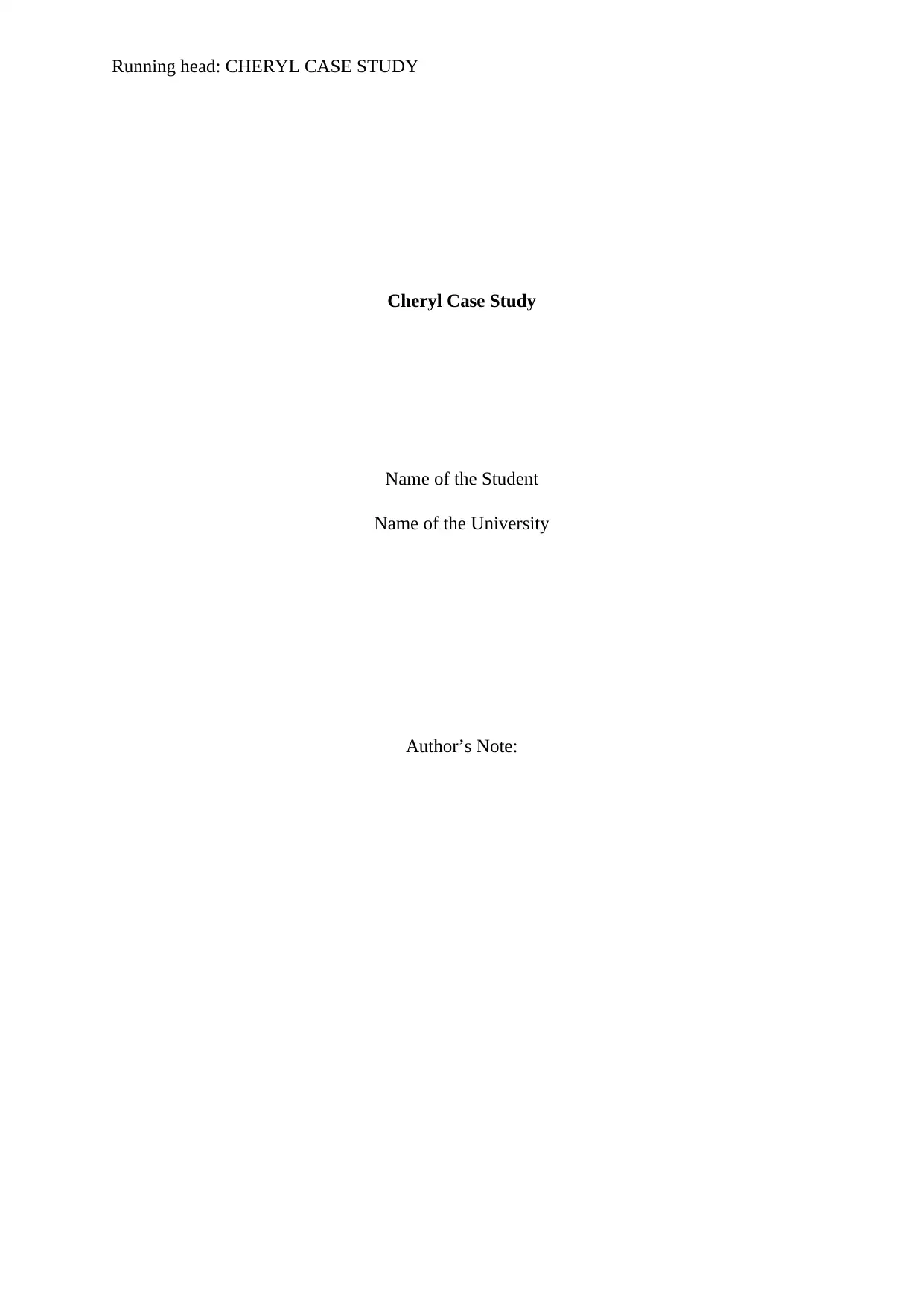
Running head: CHERYL CASE STUDY
Cheryl Case Study
Name of the Student
Name of the University
Author’s Note:
Cheryl Case Study
Name of the Student
Name of the University
Author’s Note:
Secure Best Marks with AI Grader
Need help grading? Try our AI Grader for instant feedback on your assignments.
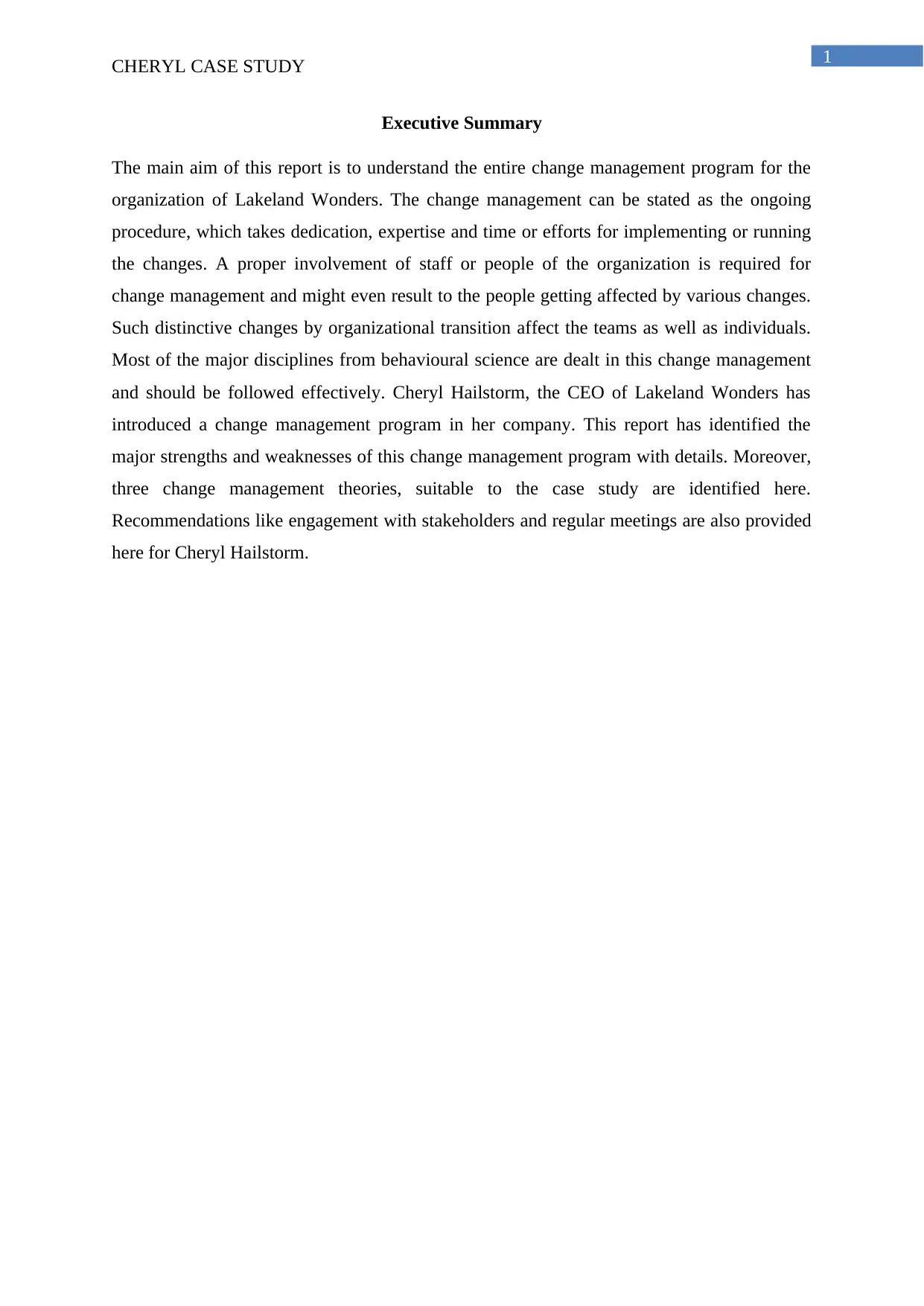
1
CHERYL CASE STUDY
Executive Summary
The main aim of this report is to understand the entire change management program for the
organization of Lakeland Wonders. The change management can be stated as the ongoing
procedure, which takes dedication, expertise and time or efforts for implementing or running
the changes. A proper involvement of staff or people of the organization is required for
change management and might even result to the people getting affected by various changes.
Such distinctive changes by organizational transition affect the teams as well as individuals.
Most of the major disciplines from behavioural science are dealt in this change management
and should be followed effectively. Cheryl Hailstorm, the CEO of Lakeland Wonders has
introduced a change management program in her company. This report has identified the
major strengths and weaknesses of this change management program with details. Moreover,
three change management theories, suitable to the case study are identified here.
Recommendations like engagement with stakeholders and regular meetings are also provided
here for Cheryl Hailstorm.
CHERYL CASE STUDY
Executive Summary
The main aim of this report is to understand the entire change management program for the
organization of Lakeland Wonders. The change management can be stated as the ongoing
procedure, which takes dedication, expertise and time or efforts for implementing or running
the changes. A proper involvement of staff or people of the organization is required for
change management and might even result to the people getting affected by various changes.
Such distinctive changes by organizational transition affect the teams as well as individuals.
Most of the major disciplines from behavioural science are dealt in this change management
and should be followed effectively. Cheryl Hailstorm, the CEO of Lakeland Wonders has
introduced a change management program in her company. This report has identified the
major strengths and weaknesses of this change management program with details. Moreover,
three change management theories, suitable to the case study are identified here.
Recommendations like engagement with stakeholders and regular meetings are also provided
here for Cheryl Hailstorm.
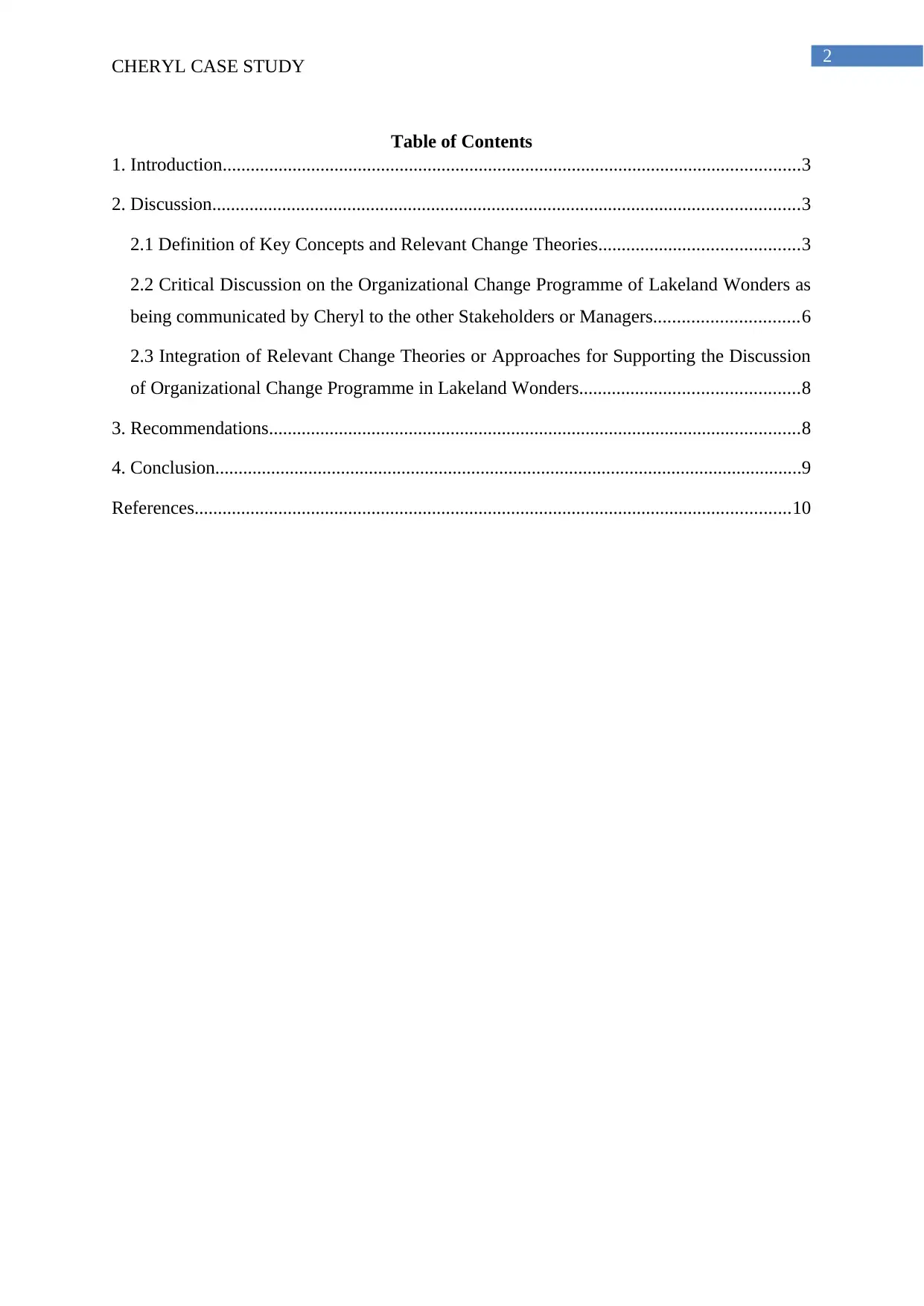
2
CHERYL CASE STUDY
Table of Contents
1. Introduction............................................................................................................................3
2. Discussion..............................................................................................................................3
2.1 Definition of Key Concepts and Relevant Change Theories...........................................3
2.2 Critical Discussion on the Organizational Change Programme of Lakeland Wonders as
being communicated by Cheryl to the other Stakeholders or Managers...............................6
2.3 Integration of Relevant Change Theories or Approaches for Supporting the Discussion
of Organizational Change Programme in Lakeland Wonders...............................................8
3. Recommendations..................................................................................................................8
4. Conclusion..............................................................................................................................9
References................................................................................................................................10
CHERYL CASE STUDY
Table of Contents
1. Introduction............................................................................................................................3
2. Discussion..............................................................................................................................3
2.1 Definition of Key Concepts and Relevant Change Theories...........................................3
2.2 Critical Discussion on the Organizational Change Programme of Lakeland Wonders as
being communicated by Cheryl to the other Stakeholders or Managers...............................6
2.3 Integration of Relevant Change Theories or Approaches for Supporting the Discussion
of Organizational Change Programme in Lakeland Wonders...............................................8
3. Recommendations..................................................................................................................8
4. Conclusion..............................................................................................................................9
References................................................................................................................................10
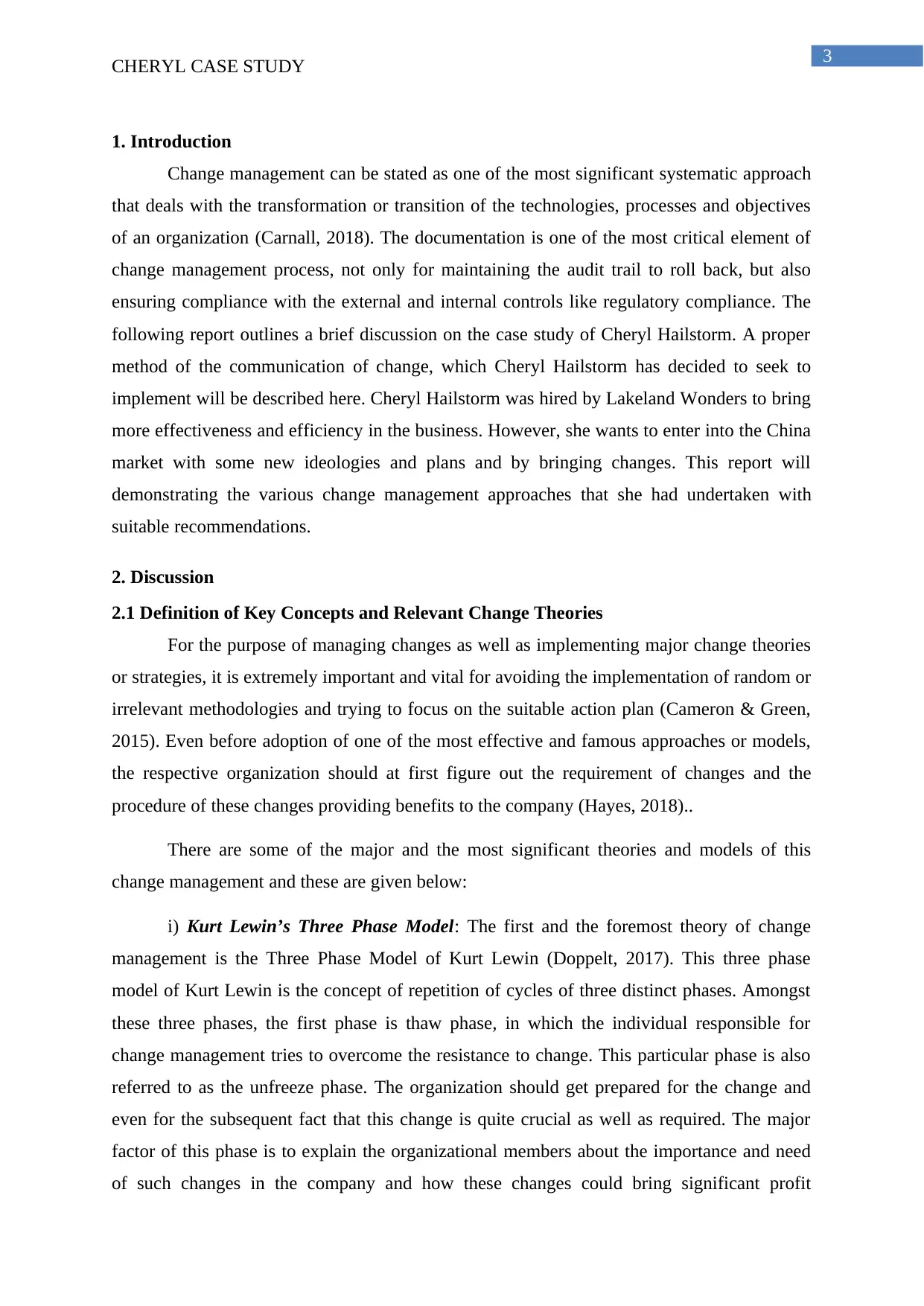
3
CHERYL CASE STUDY
1. Introduction
Change management can be stated as one of the most significant systematic approach
that deals with the transformation or transition of the technologies, processes and objectives
of an organization (Carnall, 2018). The documentation is one of the most critical element of
change management process, not only for maintaining the audit trail to roll back, but also
ensuring compliance with the external and internal controls like regulatory compliance. The
following report outlines a brief discussion on the case study of Cheryl Hailstorm. A proper
method of the communication of change, which Cheryl Hailstorm has decided to seek to
implement will be described here. Cheryl Hailstorm was hired by Lakeland Wonders to bring
more effectiveness and efficiency in the business. However, she wants to enter into the China
market with some new ideologies and plans and by bringing changes. This report will
demonstrating the various change management approaches that she had undertaken with
suitable recommendations.
2. Discussion
2.1 Definition of Key Concepts and Relevant Change Theories
For the purpose of managing changes as well as implementing major change theories
or strategies, it is extremely important and vital for avoiding the implementation of random or
irrelevant methodologies and trying to focus on the suitable action plan (Cameron & Green,
2015). Even before adoption of one of the most effective and famous approaches or models,
the respective organization should at first figure out the requirement of changes and the
procedure of these changes providing benefits to the company (Hayes, 2018)..
There are some of the major and the most significant theories and models of this
change management and these are given below:
i) Kurt Lewin’s Three Phase Model: The first and the foremost theory of change
management is the Three Phase Model of Kurt Lewin (Doppelt, 2017). This three phase
model of Kurt Lewin is the concept of repetition of cycles of three distinct phases. Amongst
these three phases, the first phase is thaw phase, in which the individual responsible for
change management tries to overcome the resistance to change. This particular phase is also
referred to as the unfreeze phase. The organization should get prepared for the change and
even for the subsequent fact that this change is quite crucial as well as required. The major
factor of this phase is to explain the organizational members about the importance and need
of such changes in the company and how these changes could bring significant profit
CHERYL CASE STUDY
1. Introduction
Change management can be stated as one of the most significant systematic approach
that deals with the transformation or transition of the technologies, processes and objectives
of an organization (Carnall, 2018). The documentation is one of the most critical element of
change management process, not only for maintaining the audit trail to roll back, but also
ensuring compliance with the external and internal controls like regulatory compliance. The
following report outlines a brief discussion on the case study of Cheryl Hailstorm. A proper
method of the communication of change, which Cheryl Hailstorm has decided to seek to
implement will be described here. Cheryl Hailstorm was hired by Lakeland Wonders to bring
more effectiveness and efficiency in the business. However, she wants to enter into the China
market with some new ideologies and plans and by bringing changes. This report will
demonstrating the various change management approaches that she had undertaken with
suitable recommendations.
2. Discussion
2.1 Definition of Key Concepts and Relevant Change Theories
For the purpose of managing changes as well as implementing major change theories
or strategies, it is extremely important and vital for avoiding the implementation of random or
irrelevant methodologies and trying to focus on the suitable action plan (Cameron & Green,
2015). Even before adoption of one of the most effective and famous approaches or models,
the respective organization should at first figure out the requirement of changes and the
procedure of these changes providing benefits to the company (Hayes, 2018)..
There are some of the major and the most significant theories and models of this
change management and these are given below:
i) Kurt Lewin’s Three Phase Model: The first and the foremost theory of change
management is the Three Phase Model of Kurt Lewin (Doppelt, 2017). This three phase
model of Kurt Lewin is the concept of repetition of cycles of three distinct phases. Amongst
these three phases, the first phase is thaw phase, in which the individual responsible for
change management tries to overcome the resistance to change. This particular phase is also
referred to as the unfreeze phase. The organization should get prepared for the change and
even for the subsequent fact that this change is quite crucial as well as required. The major
factor of this phase is to explain the organizational members about the importance and need
of such changes in the company and how these changes could bring significant profit
Secure Best Marks with AI Grader
Need help grading? Try our AI Grader for instant feedback on your assignments.
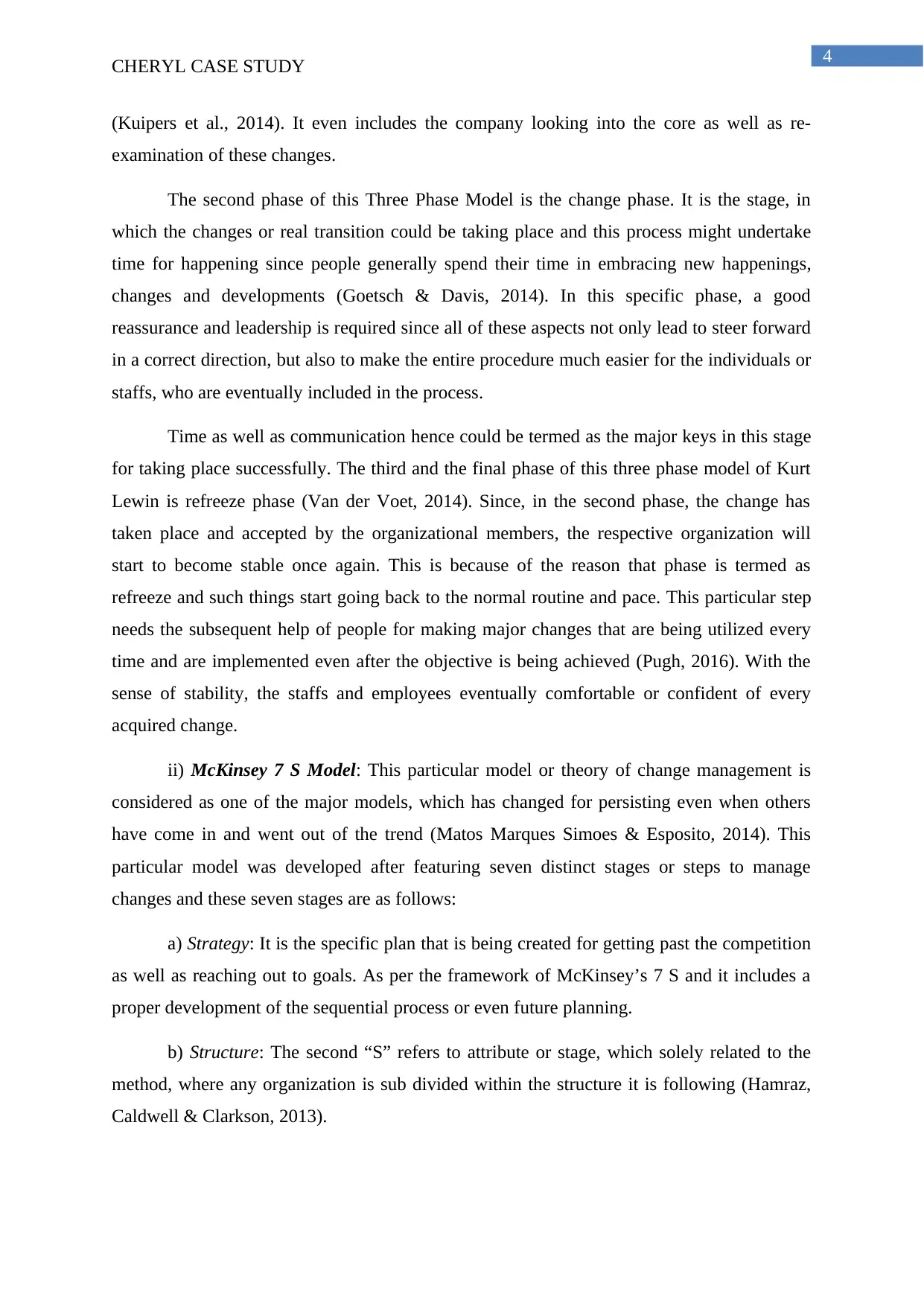
4
CHERYL CASE STUDY
(Kuipers et al., 2014). It even includes the company looking into the core as well as re-
examination of these changes.
The second phase of this Three Phase Model is the change phase. It is the stage, in
which the changes or real transition could be taking place and this process might undertake
time for happening since people generally spend their time in embracing new happenings,
changes and developments (Goetsch & Davis, 2014). In this specific phase, a good
reassurance and leadership is required since all of these aspects not only lead to steer forward
in a correct direction, but also to make the entire procedure much easier for the individuals or
staffs, who are eventually included in the process.
Time as well as communication hence could be termed as the major keys in this stage
for taking place successfully. The third and the final phase of this three phase model of Kurt
Lewin is refreeze phase (Van der Voet, 2014). Since, in the second phase, the change has
taken place and accepted by the organizational members, the respective organization will
start to become stable once again. This is because of the reason that phase is termed as
refreeze and such things start going back to the normal routine and pace. This particular step
needs the subsequent help of people for making major changes that are being utilized every
time and are implemented even after the objective is being achieved (Pugh, 2016). With the
sense of stability, the staffs and employees eventually comfortable or confident of every
acquired change.
ii) McKinsey 7 S Model: This particular model or theory of change management is
considered as one of the major models, which has changed for persisting even when others
have come in and went out of the trend (Matos Marques Simoes & Esposito, 2014). This
particular model was developed after featuring seven distinct stages or steps to manage
changes and these seven stages are as follows:
a) Strategy: It is the specific plan that is being created for getting past the competition
as well as reaching out to goals. As per the framework of McKinsey’s 7 S and it includes a
proper development of the sequential process or even future planning.
b) Structure: The second “S” refers to attribute or stage, which solely related to the
method, where any organization is sub divided within the structure it is following (Hamraz,
Caldwell & Clarkson, 2013).
CHERYL CASE STUDY
(Kuipers et al., 2014). It even includes the company looking into the core as well as re-
examination of these changes.
The second phase of this Three Phase Model is the change phase. It is the stage, in
which the changes or real transition could be taking place and this process might undertake
time for happening since people generally spend their time in embracing new happenings,
changes and developments (Goetsch & Davis, 2014). In this specific phase, a good
reassurance and leadership is required since all of these aspects not only lead to steer forward
in a correct direction, but also to make the entire procedure much easier for the individuals or
staffs, who are eventually included in the process.
Time as well as communication hence could be termed as the major keys in this stage
for taking place successfully. The third and the final phase of this three phase model of Kurt
Lewin is refreeze phase (Van der Voet, 2014). Since, in the second phase, the change has
taken place and accepted by the organizational members, the respective organization will
start to become stable once again. This is because of the reason that phase is termed as
refreeze and such things start going back to the normal routine and pace. This particular step
needs the subsequent help of people for making major changes that are being utilized every
time and are implemented even after the objective is being achieved (Pugh, 2016). With the
sense of stability, the staffs and employees eventually comfortable or confident of every
acquired change.
ii) McKinsey 7 S Model: This particular model or theory of change management is
considered as one of the major models, which has changed for persisting even when others
have come in and went out of the trend (Matos Marques Simoes & Esposito, 2014). This
particular model was developed after featuring seven distinct stages or steps to manage
changes and these seven stages are as follows:
a) Strategy: It is the specific plan that is being created for getting past the competition
as well as reaching out to goals. As per the framework of McKinsey’s 7 S and it includes a
proper development of the sequential process or even future planning.
b) Structure: The second “S” refers to attribute or stage, which solely related to the
method, where any organization is sub divided within the structure it is following (Hamraz,
Caldwell & Clarkson, 2013).
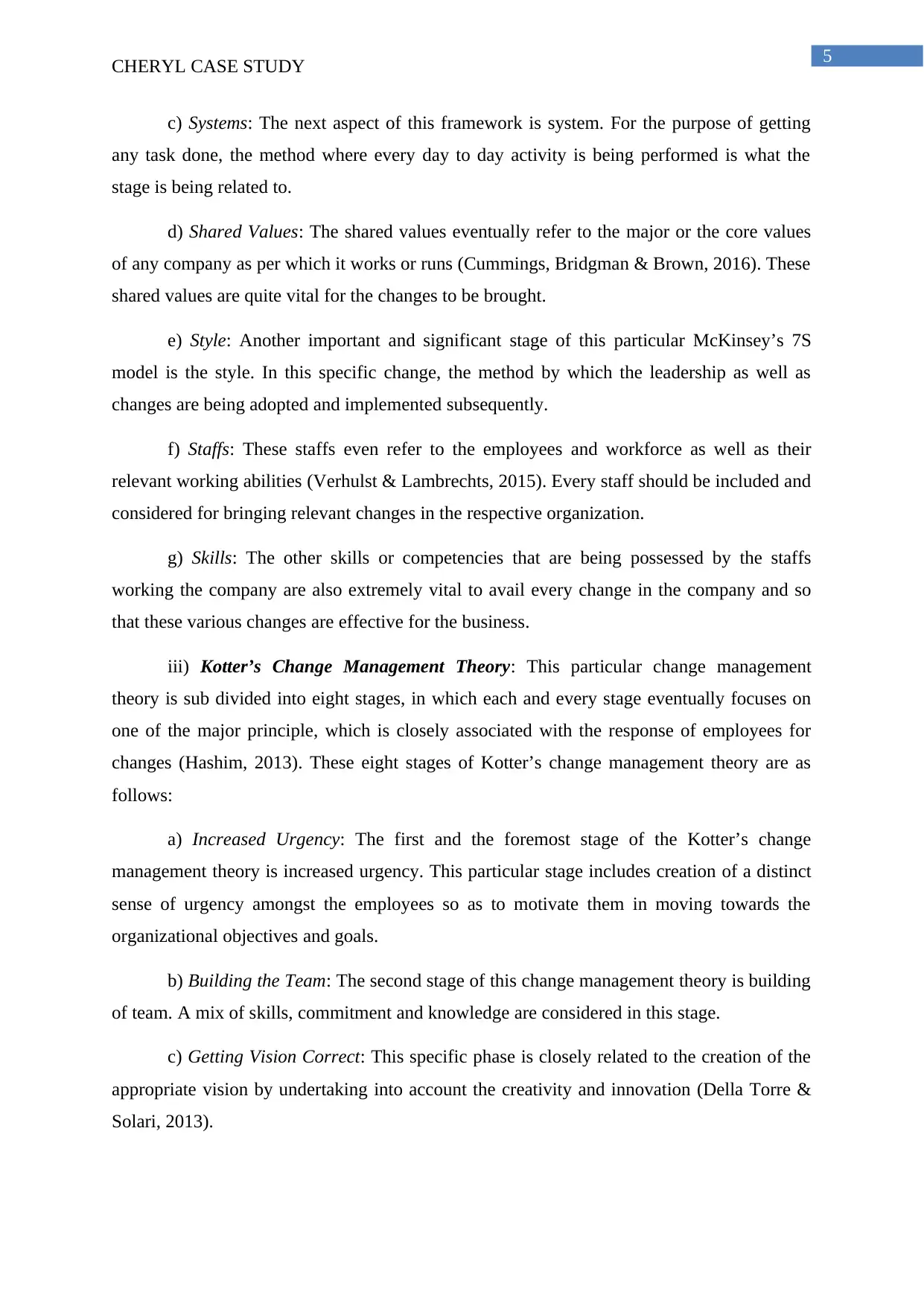
5
CHERYL CASE STUDY
c) Systems: The next aspect of this framework is system. For the purpose of getting
any task done, the method where every day to day activity is being performed is what the
stage is being related to.
d) Shared Values: The shared values eventually refer to the major or the core values
of any company as per which it works or runs (Cummings, Bridgman & Brown, 2016). These
shared values are quite vital for the changes to be brought.
e) Style: Another important and significant stage of this particular McKinsey’s 7S
model is the style. In this specific change, the method by which the leadership as well as
changes are being adopted and implemented subsequently.
f) Staffs: These staffs even refer to the employees and workforce as well as their
relevant working abilities (Verhulst & Lambrechts, 2015). Every staff should be included and
considered for bringing relevant changes in the respective organization.
g) Skills: The other skills or competencies that are being possessed by the staffs
working the company are also extremely vital to avail every change in the company and so
that these various changes are effective for the business.
iii) Kotter’s Change Management Theory: This particular change management
theory is sub divided into eight stages, in which each and every stage eventually focuses on
one of the major principle, which is closely associated with the response of employees for
changes (Hashim, 2013). These eight stages of Kotter’s change management theory are as
follows:
a) Increased Urgency: The first and the foremost stage of the Kotter’s change
management theory is increased urgency. This particular stage includes creation of a distinct
sense of urgency amongst the employees so as to motivate them in moving towards the
organizational objectives and goals.
b) Building the Team: The second stage of this change management theory is building
of team. A mix of skills, commitment and knowledge are considered in this stage.
c) Getting Vision Correct: This specific phase is closely related to the creation of the
appropriate vision by undertaking into account the creativity and innovation (Della Torre &
Solari, 2013).
CHERYL CASE STUDY
c) Systems: The next aspect of this framework is system. For the purpose of getting
any task done, the method where every day to day activity is being performed is what the
stage is being related to.
d) Shared Values: The shared values eventually refer to the major or the core values
of any company as per which it works or runs (Cummings, Bridgman & Brown, 2016). These
shared values are quite vital for the changes to be brought.
e) Style: Another important and significant stage of this particular McKinsey’s 7S
model is the style. In this specific change, the method by which the leadership as well as
changes are being adopted and implemented subsequently.
f) Staffs: These staffs even refer to the employees and workforce as well as their
relevant working abilities (Verhulst & Lambrechts, 2015). Every staff should be included and
considered for bringing relevant changes in the respective organization.
g) Skills: The other skills or competencies that are being possessed by the staffs
working the company are also extremely vital to avail every change in the company and so
that these various changes are effective for the business.
iii) Kotter’s Change Management Theory: This particular change management
theory is sub divided into eight stages, in which each and every stage eventually focuses on
one of the major principle, which is closely associated with the response of employees for
changes (Hashim, 2013). These eight stages of Kotter’s change management theory are as
follows:
a) Increased Urgency: The first and the foremost stage of the Kotter’s change
management theory is increased urgency. This particular stage includes creation of a distinct
sense of urgency amongst the employees so as to motivate them in moving towards the
organizational objectives and goals.
b) Building the Team: The second stage of this change management theory is building
of team. A mix of skills, commitment and knowledge are considered in this stage.
c) Getting Vision Correct: This specific phase is closely related to the creation of the
appropriate vision by undertaking into account the creativity and innovation (Della Torre &
Solari, 2013).

6
CHERYL CASE STUDY
d) Communication: A proper communication with the employees is extremely vital
for availing the changes in the organization.
e) Getting Things Moving: For getting things moving and empowering action, any
employee requires to get proper support, removal of roadblocks and finally implementing
feedbacks.
f) Focusing of Short Term Goals: Next, the short term goals are needed to be focused
on and for this reason, a proper division of long term goals is highly needed.
g) Not Giving Up: As persistence is the key towards success, it is vital to not to give
up under any circumstance and the employees are required to be made understand.
h) Incorporation of Changes: The proper incorporation of changes besides change
management, it is vital for reinforcing and making it a part of the work culture (Uhl &
Gollenia, 2016).
2.2 Critical Discussion on the Organizational Change Programme of Lakeland Wonders
as being communicated by Cheryl to the other Stakeholders or Managers
Cheryl Hailstorm has decided to bring change management in her organization of
Lakeland Wonders. She has communicated with the rest of the managers and stakeholders of
the company, regarding these changes and has ensured that such changes should be brought
for the benefit of the organization (Gattermeyer & Al-Ani, 2013). Cheryl has decided to bring
new people in the company so that this organization gets the chance of getting new ideas ad
methods. The most significant change in the change program of Cheryl for this particular
organization is the flexibility of time.
She has noticed that after 6.30 pm in the evening, no employee has the potential of
working in the company and this is required to be changed under every circumstance.
Moreover, she wants to remove the family oriented traditions in the 94 years old company so
that new ideas are launched and they get the core opportunity of launching in the China
market. Being one of the major player is Minnesota, it is quite vital for Lakeland Wonders to
enter into the China market (Kash et al., 2014). Due to the lack of changes and higher target
growth, Cheryl wanted changes in facilities, manufacturing process, human resource
management and maintenance unit. For enhancing the target market, she decided to enhance
the target market by simply venturing to respective off shore manufacturing for client
satisfaction.
CHERYL CASE STUDY
d) Communication: A proper communication with the employees is extremely vital
for availing the changes in the organization.
e) Getting Things Moving: For getting things moving and empowering action, any
employee requires to get proper support, removal of roadblocks and finally implementing
feedbacks.
f) Focusing of Short Term Goals: Next, the short term goals are needed to be focused
on and for this reason, a proper division of long term goals is highly needed.
g) Not Giving Up: As persistence is the key towards success, it is vital to not to give
up under any circumstance and the employees are required to be made understand.
h) Incorporation of Changes: The proper incorporation of changes besides change
management, it is vital for reinforcing and making it a part of the work culture (Uhl &
Gollenia, 2016).
2.2 Critical Discussion on the Organizational Change Programme of Lakeland Wonders
as being communicated by Cheryl to the other Stakeholders or Managers
Cheryl Hailstorm has decided to bring change management in her organization of
Lakeland Wonders. She has communicated with the rest of the managers and stakeholders of
the company, regarding these changes and has ensured that such changes should be brought
for the benefit of the organization (Gattermeyer & Al-Ani, 2013). Cheryl has decided to bring
new people in the company so that this organization gets the chance of getting new ideas ad
methods. The most significant change in the change program of Cheryl for this particular
organization is the flexibility of time.
She has noticed that after 6.30 pm in the evening, no employee has the potential of
working in the company and this is required to be changed under every circumstance.
Moreover, she wants to remove the family oriented traditions in the 94 years old company so
that new ideas are launched and they get the core opportunity of launching in the China
market. Being one of the major player is Minnesota, it is quite vital for Lakeland Wonders to
enter into the China market (Kash et al., 2014). Due to the lack of changes and higher target
growth, Cheryl wanted changes in facilities, manufacturing process, human resource
management and maintenance unit. For enhancing the target market, she decided to enhance
the target market by simply venturing to respective off shore manufacturing for client
satisfaction.
Paraphrase This Document
Need a fresh take? Get an instant paraphrase of this document with our AI Paraphraser
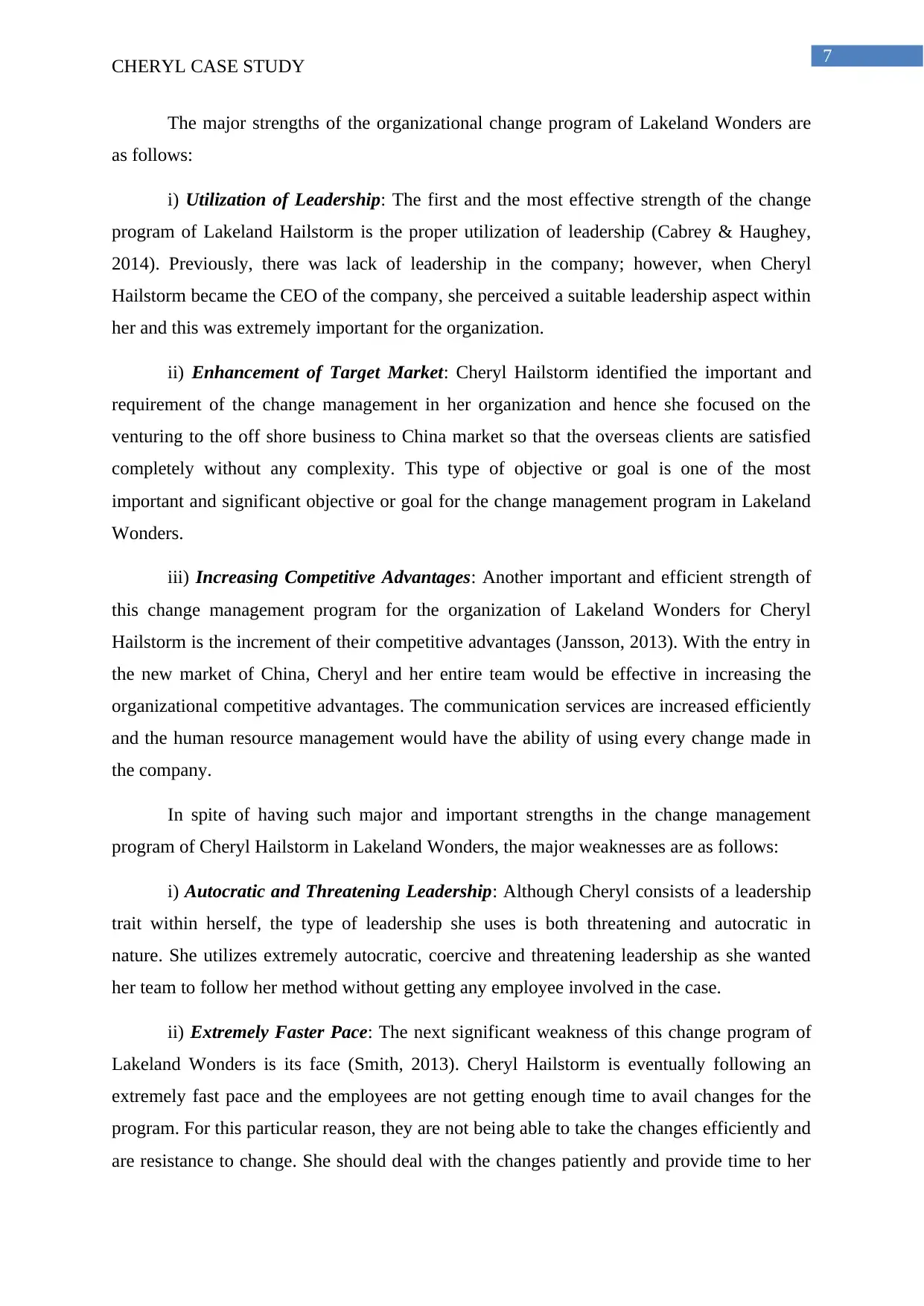
7
CHERYL CASE STUDY
The major strengths of the organizational change program of Lakeland Wonders are
as follows:
i) Utilization of Leadership: The first and the most effective strength of the change
program of Lakeland Hailstorm is the proper utilization of leadership (Cabrey & Haughey,
2014). Previously, there was lack of leadership in the company; however, when Cheryl
Hailstorm became the CEO of the company, she perceived a suitable leadership aspect within
her and this was extremely important for the organization.
ii) Enhancement of Target Market: Cheryl Hailstorm identified the important and
requirement of the change management in her organization and hence she focused on the
venturing to the off shore business to China market so that the overseas clients are satisfied
completely without any complexity. This type of objective or goal is one of the most
important and significant objective or goal for the change management program in Lakeland
Wonders.
iii) Increasing Competitive Advantages: Another important and efficient strength of
this change management program for the organization of Lakeland Wonders for Cheryl
Hailstorm is the increment of their competitive advantages (Jansson, 2013). With the entry in
the new market of China, Cheryl and her entire team would be effective in increasing the
organizational competitive advantages. The communication services are increased efficiently
and the human resource management would have the ability of using every change made in
the company.
In spite of having such major and important strengths in the change management
program of Cheryl Hailstorm in Lakeland Wonders, the major weaknesses are as follows:
i) Autocratic and Threatening Leadership: Although Cheryl consists of a leadership
trait within herself, the type of leadership she uses is both threatening and autocratic in
nature. She utilizes extremely autocratic, coercive and threatening leadership as she wanted
her team to follow her method without getting any employee involved in the case.
ii) Extremely Faster Pace: The next significant weakness of this change program of
Lakeland Wonders is its face (Smith, 2013). Cheryl Hailstorm is eventually following an
extremely fast pace and the employees are not getting enough time to avail changes for the
program. For this particular reason, they are not being able to take the changes efficiently and
are resistance to change. She should deal with the changes patiently and provide time to her
CHERYL CASE STUDY
The major strengths of the organizational change program of Lakeland Wonders are
as follows:
i) Utilization of Leadership: The first and the most effective strength of the change
program of Lakeland Hailstorm is the proper utilization of leadership (Cabrey & Haughey,
2014). Previously, there was lack of leadership in the company; however, when Cheryl
Hailstorm became the CEO of the company, she perceived a suitable leadership aspect within
her and this was extremely important for the organization.
ii) Enhancement of Target Market: Cheryl Hailstorm identified the important and
requirement of the change management in her organization and hence she focused on the
venturing to the off shore business to China market so that the overseas clients are satisfied
completely without any complexity. This type of objective or goal is one of the most
important and significant objective or goal for the change management program in Lakeland
Wonders.
iii) Increasing Competitive Advantages: Another important and efficient strength of
this change management program for the organization of Lakeland Wonders for Cheryl
Hailstorm is the increment of their competitive advantages (Jansson, 2013). With the entry in
the new market of China, Cheryl and her entire team would be effective in increasing the
organizational competitive advantages. The communication services are increased efficiently
and the human resource management would have the ability of using every change made in
the company.
In spite of having such major and important strengths in the change management
program of Cheryl Hailstorm in Lakeland Wonders, the major weaknesses are as follows:
i) Autocratic and Threatening Leadership: Although Cheryl consists of a leadership
trait within herself, the type of leadership she uses is both threatening and autocratic in
nature. She utilizes extremely autocratic, coercive and threatening leadership as she wanted
her team to follow her method without getting any employee involved in the case.
ii) Extremely Faster Pace: The next significant weakness of this change program of
Lakeland Wonders is its face (Smith, 2013). Cheryl Hailstorm is eventually following an
extremely fast pace and the employees are not getting enough time to avail changes for the
program. For this particular reason, they are not being able to take the changes efficiently and
are resistance to change. She should deal with the changes patiently and provide time to her
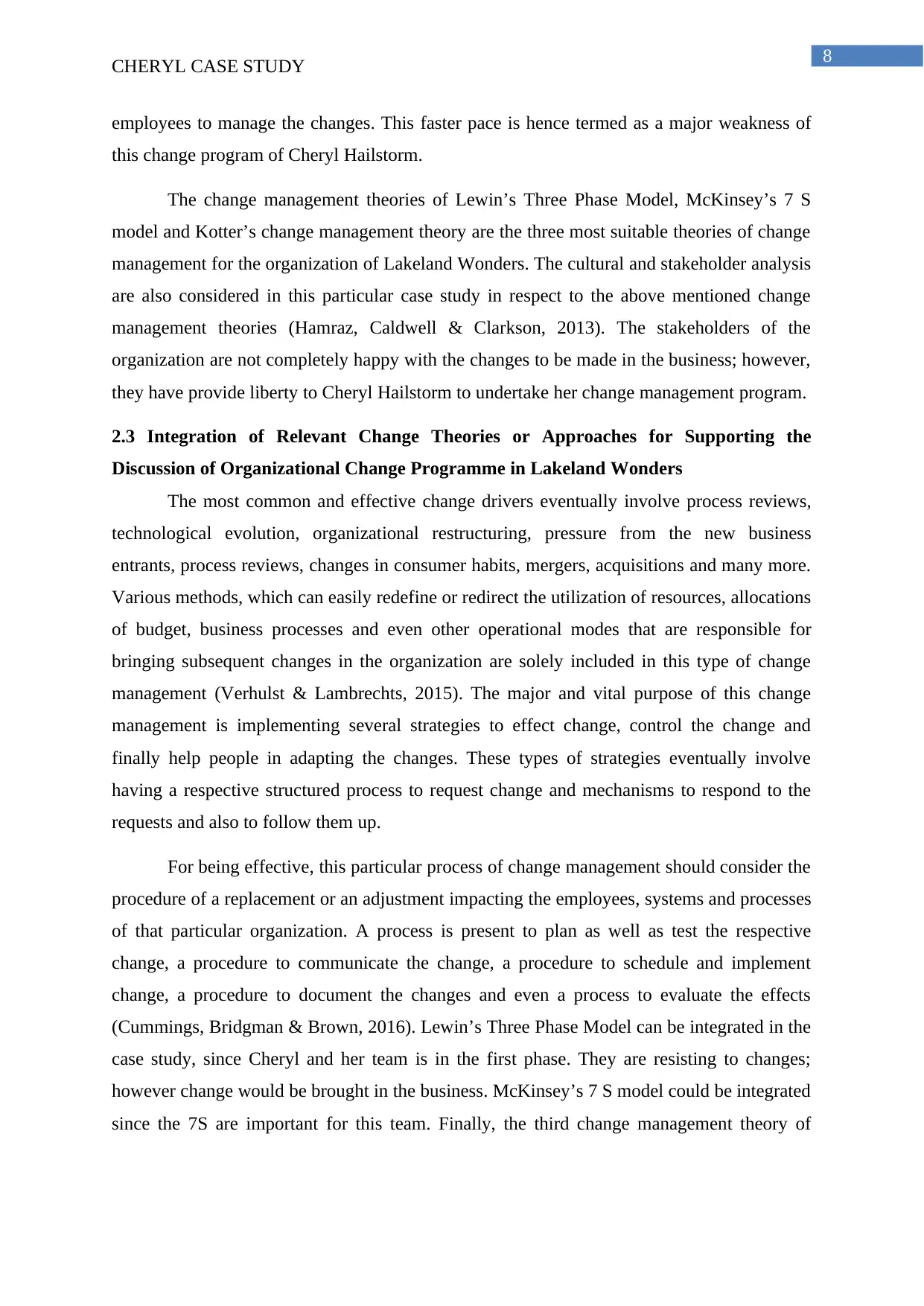
8
CHERYL CASE STUDY
employees to manage the changes. This faster pace is hence termed as a major weakness of
this change program of Cheryl Hailstorm.
The change management theories of Lewin’s Three Phase Model, McKinsey’s 7 S
model and Kotter’s change management theory are the three most suitable theories of change
management for the organization of Lakeland Wonders. The cultural and stakeholder analysis
are also considered in this particular case study in respect to the above mentioned change
management theories (Hamraz, Caldwell & Clarkson, 2013). The stakeholders of the
organization are not completely happy with the changes to be made in the business; however,
they have provide liberty to Cheryl Hailstorm to undertake her change management program.
2.3 Integration of Relevant Change Theories or Approaches for Supporting the
Discussion of Organizational Change Programme in Lakeland Wonders
The most common and effective change drivers eventually involve process reviews,
technological evolution, organizational restructuring, pressure from the new business
entrants, process reviews, changes in consumer habits, mergers, acquisitions and many more.
Various methods, which can easily redefine or redirect the utilization of resources, allocations
of budget, business processes and even other operational modes that are responsible for
bringing subsequent changes in the organization are solely included in this type of change
management (Verhulst & Lambrechts, 2015). The major and vital purpose of this change
management is implementing several strategies to effect change, control the change and
finally help people in adapting the changes. These types of strategies eventually involve
having a respective structured process to request change and mechanisms to respond to the
requests and also to follow them up.
For being effective, this particular process of change management should consider the
procedure of a replacement or an adjustment impacting the employees, systems and processes
of that particular organization. A process is present to plan as well as test the respective
change, a procedure to communicate the change, a procedure to schedule and implement
change, a procedure to document the changes and even a process to evaluate the effects
(Cummings, Bridgman & Brown, 2016). Lewin’s Three Phase Model can be integrated in the
case study, since Cheryl and her team is in the first phase. They are resisting to changes;
however change would be brought in the business. McKinsey’s 7 S model could be integrated
since the 7S are important for this team. Finally, the third change management theory of
CHERYL CASE STUDY
employees to manage the changes. This faster pace is hence termed as a major weakness of
this change program of Cheryl Hailstorm.
The change management theories of Lewin’s Three Phase Model, McKinsey’s 7 S
model and Kotter’s change management theory are the three most suitable theories of change
management for the organization of Lakeland Wonders. The cultural and stakeholder analysis
are also considered in this particular case study in respect to the above mentioned change
management theories (Hamraz, Caldwell & Clarkson, 2013). The stakeholders of the
organization are not completely happy with the changes to be made in the business; however,
they have provide liberty to Cheryl Hailstorm to undertake her change management program.
2.3 Integration of Relevant Change Theories or Approaches for Supporting the
Discussion of Organizational Change Programme in Lakeland Wonders
The most common and effective change drivers eventually involve process reviews,
technological evolution, organizational restructuring, pressure from the new business
entrants, process reviews, changes in consumer habits, mergers, acquisitions and many more.
Various methods, which can easily redefine or redirect the utilization of resources, allocations
of budget, business processes and even other operational modes that are responsible for
bringing subsequent changes in the organization are solely included in this type of change
management (Verhulst & Lambrechts, 2015). The major and vital purpose of this change
management is implementing several strategies to effect change, control the change and
finally help people in adapting the changes. These types of strategies eventually involve
having a respective structured process to request change and mechanisms to respond to the
requests and also to follow them up.
For being effective, this particular process of change management should consider the
procedure of a replacement or an adjustment impacting the employees, systems and processes
of that particular organization. A process is present to plan as well as test the respective
change, a procedure to communicate the change, a procedure to schedule and implement
change, a procedure to document the changes and even a process to evaluate the effects
(Cummings, Bridgman & Brown, 2016). Lewin’s Three Phase Model can be integrated in the
case study, since Cheryl and her team is in the first phase. They are resisting to changes;
however change would be brought in the business. McKinsey’s 7 S model could be integrated
since the 7S are important for this team. Finally, the third change management theory of
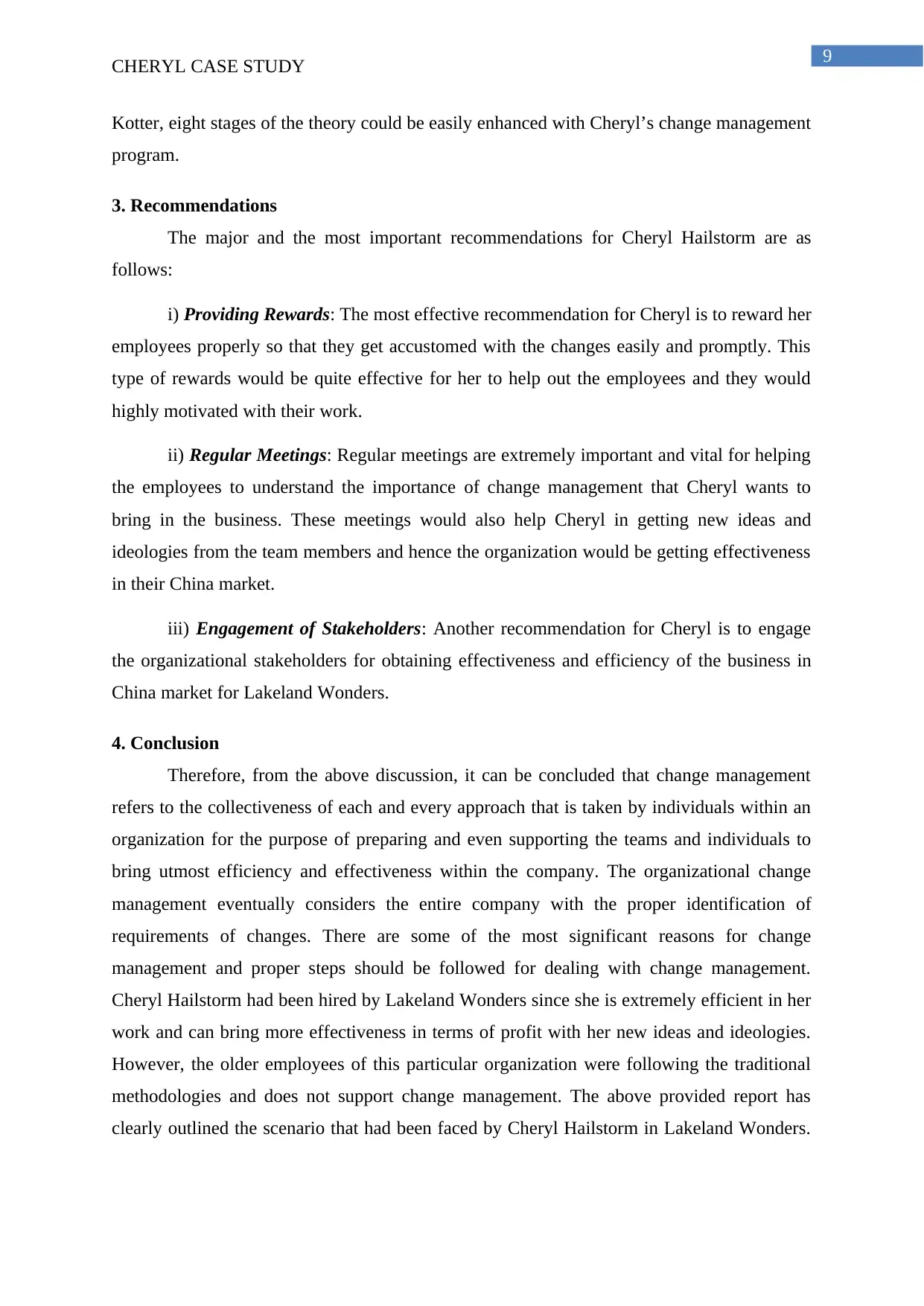
9
CHERYL CASE STUDY
Kotter, eight stages of the theory could be easily enhanced with Cheryl’s change management
program.
3. Recommendations
The major and the most important recommendations for Cheryl Hailstorm are as
follows:
i) Providing Rewards: The most effective recommendation for Cheryl is to reward her
employees properly so that they get accustomed with the changes easily and promptly. This
type of rewards would be quite effective for her to help out the employees and they would
highly motivated with their work.
ii) Regular Meetings: Regular meetings are extremely important and vital for helping
the employees to understand the importance of change management that Cheryl wants to
bring in the business. These meetings would also help Cheryl in getting new ideas and
ideologies from the team members and hence the organization would be getting effectiveness
in their China market.
iii) Engagement of Stakeholders: Another recommendation for Cheryl is to engage
the organizational stakeholders for obtaining effectiveness and efficiency of the business in
China market for Lakeland Wonders.
4. Conclusion
Therefore, from the above discussion, it can be concluded that change management
refers to the collectiveness of each and every approach that is taken by individuals within an
organization for the purpose of preparing and even supporting the teams and individuals to
bring utmost efficiency and effectiveness within the company. The organizational change
management eventually considers the entire company with the proper identification of
requirements of changes. There are some of the most significant reasons for change
management and proper steps should be followed for dealing with change management.
Cheryl Hailstorm had been hired by Lakeland Wonders since she is extremely efficient in her
work and can bring more effectiveness in terms of profit with her new ideas and ideologies.
However, the older employees of this particular organization were following the traditional
methodologies and does not support change management. The above provided report has
clearly outlined the scenario that had been faced by Cheryl Hailstorm in Lakeland Wonders.
CHERYL CASE STUDY
Kotter, eight stages of the theory could be easily enhanced with Cheryl’s change management
program.
3. Recommendations
The major and the most important recommendations for Cheryl Hailstorm are as
follows:
i) Providing Rewards: The most effective recommendation for Cheryl is to reward her
employees properly so that they get accustomed with the changes easily and promptly. This
type of rewards would be quite effective for her to help out the employees and they would
highly motivated with their work.
ii) Regular Meetings: Regular meetings are extremely important and vital for helping
the employees to understand the importance of change management that Cheryl wants to
bring in the business. These meetings would also help Cheryl in getting new ideas and
ideologies from the team members and hence the organization would be getting effectiveness
in their China market.
iii) Engagement of Stakeholders: Another recommendation for Cheryl is to engage
the organizational stakeholders for obtaining effectiveness and efficiency of the business in
China market for Lakeland Wonders.
4. Conclusion
Therefore, from the above discussion, it can be concluded that change management
refers to the collectiveness of each and every approach that is taken by individuals within an
organization for the purpose of preparing and even supporting the teams and individuals to
bring utmost efficiency and effectiveness within the company. The organizational change
management eventually considers the entire company with the proper identification of
requirements of changes. There are some of the most significant reasons for change
management and proper steps should be followed for dealing with change management.
Cheryl Hailstorm had been hired by Lakeland Wonders since she is extremely efficient in her
work and can bring more effectiveness in terms of profit with her new ideas and ideologies.
However, the older employees of this particular organization were following the traditional
methodologies and does not support change management. The above provided report has
clearly outlined the scenario that had been faced by Cheryl Hailstorm in Lakeland Wonders.
Secure Best Marks with AI Grader
Need help grading? Try our AI Grader for instant feedback on your assignments.

10
CHERYL CASE STUDY
The major and most effective change theories are provided in this report with subsequent
recommendations.
CHERYL CASE STUDY
The major and most effective change theories are provided in this report with subsequent
recommendations.
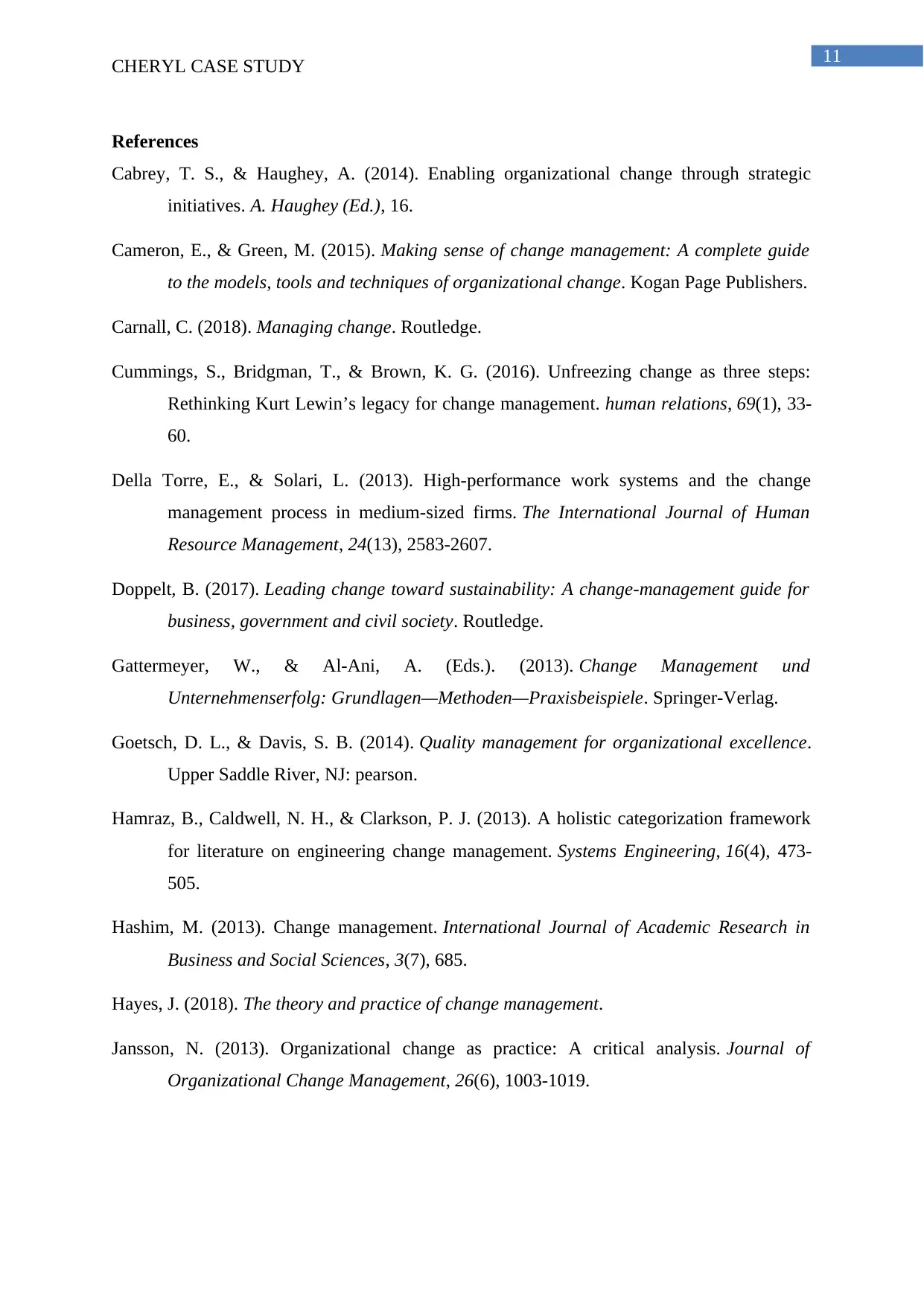
11
CHERYL CASE STUDY
References
Cabrey, T. S., & Haughey, A. (2014). Enabling organizational change through strategic
initiatives. A. Haughey (Ed.), 16.
Cameron, E., & Green, M. (2015). Making sense of change management: A complete guide
to the models, tools and techniques of organizational change. Kogan Page Publishers.
Carnall, C. (2018). Managing change. Routledge.
Cummings, S., Bridgman, T., & Brown, K. G. (2016). Unfreezing change as three steps:
Rethinking Kurt Lewin’s legacy for change management. human relations, 69(1), 33-
60.
Della Torre, E., & Solari, L. (2013). High-performance work systems and the change
management process in medium-sized firms. The International Journal of Human
Resource Management, 24(13), 2583-2607.
Doppelt, B. (2017). Leading change toward sustainability: A change-management guide for
business, government and civil society. Routledge.
Gattermeyer, W., & Al-Ani, A. (Eds.). (2013). Change Management und
Unternehmenserfolg: Grundlagen—Methoden—Praxisbeispiele. Springer-Verlag.
Goetsch, D. L., & Davis, S. B. (2014). Quality management for organizational excellence.
Upper Saddle River, NJ: pearson.
Hamraz, B., Caldwell, N. H., & Clarkson, P. J. (2013). A holistic categorization framework
for literature on engineering change management. Systems Engineering, 16(4), 473-
505.
Hashim, M. (2013). Change management. International Journal of Academic Research in
Business and Social Sciences, 3(7), 685.
Hayes, J. (2018). The theory and practice of change management.
Jansson, N. (2013). Organizational change as practice: A critical analysis. Journal of
Organizational Change Management, 26(6), 1003-1019.
CHERYL CASE STUDY
References
Cabrey, T. S., & Haughey, A. (2014). Enabling organizational change through strategic
initiatives. A. Haughey (Ed.), 16.
Cameron, E., & Green, M. (2015). Making sense of change management: A complete guide
to the models, tools and techniques of organizational change. Kogan Page Publishers.
Carnall, C. (2018). Managing change. Routledge.
Cummings, S., Bridgman, T., & Brown, K. G. (2016). Unfreezing change as three steps:
Rethinking Kurt Lewin’s legacy for change management. human relations, 69(1), 33-
60.
Della Torre, E., & Solari, L. (2013). High-performance work systems and the change
management process in medium-sized firms. The International Journal of Human
Resource Management, 24(13), 2583-2607.
Doppelt, B. (2017). Leading change toward sustainability: A change-management guide for
business, government and civil society. Routledge.
Gattermeyer, W., & Al-Ani, A. (Eds.). (2013). Change Management und
Unternehmenserfolg: Grundlagen—Methoden—Praxisbeispiele. Springer-Verlag.
Goetsch, D. L., & Davis, S. B. (2014). Quality management for organizational excellence.
Upper Saddle River, NJ: pearson.
Hamraz, B., Caldwell, N. H., & Clarkson, P. J. (2013). A holistic categorization framework
for literature on engineering change management. Systems Engineering, 16(4), 473-
505.
Hashim, M. (2013). Change management. International Journal of Academic Research in
Business and Social Sciences, 3(7), 685.
Hayes, J. (2018). The theory and practice of change management.
Jansson, N. (2013). Organizational change as practice: A critical analysis. Journal of
Organizational Change Management, 26(6), 1003-1019.
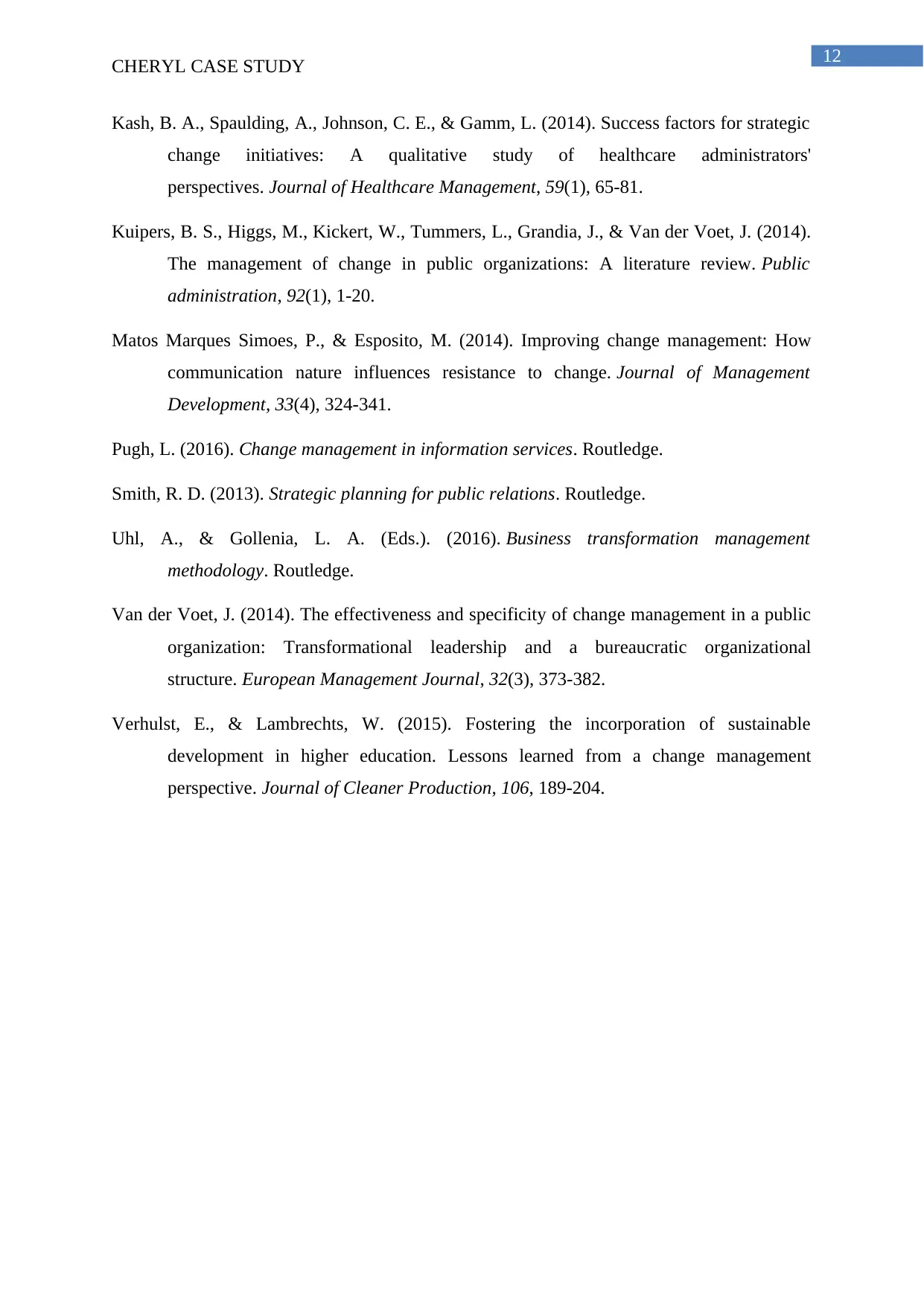
12
CHERYL CASE STUDY
Kash, B. A., Spaulding, A., Johnson, C. E., & Gamm, L. (2014). Success factors for strategic
change initiatives: A qualitative study of healthcare administrators'
perspectives. Journal of Healthcare Management, 59(1), 65-81.
Kuipers, B. S., Higgs, M., Kickert, W., Tummers, L., Grandia, J., & Van der Voet, J. (2014).
The management of change in public organizations: A literature review. Public
administration, 92(1), 1-20.
Matos Marques Simoes, P., & Esposito, M. (2014). Improving change management: How
communication nature influences resistance to change. Journal of Management
Development, 33(4), 324-341.
Pugh, L. (2016). Change management in information services. Routledge.
Smith, R. D. (2013). Strategic planning for public relations. Routledge.
Uhl, A., & Gollenia, L. A. (Eds.). (2016). Business transformation management
methodology. Routledge.
Van der Voet, J. (2014). The effectiveness and specificity of change management in a public
organization: Transformational leadership and a bureaucratic organizational
structure. European Management Journal, 32(3), 373-382.
Verhulst, E., & Lambrechts, W. (2015). Fostering the incorporation of sustainable
development in higher education. Lessons learned from a change management
perspective. Journal of Cleaner Production, 106, 189-204.
CHERYL CASE STUDY
Kash, B. A., Spaulding, A., Johnson, C. E., & Gamm, L. (2014). Success factors for strategic
change initiatives: A qualitative study of healthcare administrators'
perspectives. Journal of Healthcare Management, 59(1), 65-81.
Kuipers, B. S., Higgs, M., Kickert, W., Tummers, L., Grandia, J., & Van der Voet, J. (2014).
The management of change in public organizations: A literature review. Public
administration, 92(1), 1-20.
Matos Marques Simoes, P., & Esposito, M. (2014). Improving change management: How
communication nature influences resistance to change. Journal of Management
Development, 33(4), 324-341.
Pugh, L. (2016). Change management in information services. Routledge.
Smith, R. D. (2013). Strategic planning for public relations. Routledge.
Uhl, A., & Gollenia, L. A. (Eds.). (2016). Business transformation management
methodology. Routledge.
Van der Voet, J. (2014). The effectiveness and specificity of change management in a public
organization: Transformational leadership and a bureaucratic organizational
structure. European Management Journal, 32(3), 373-382.
Verhulst, E., & Lambrechts, W. (2015). Fostering the incorporation of sustainable
development in higher education. Lessons learned from a change management
perspective. Journal of Cleaner Production, 106, 189-204.
1 out of 13
Related Documents
Your All-in-One AI-Powered Toolkit for Academic Success.
+13062052269
info@desklib.com
Available 24*7 on WhatsApp / Email
![[object Object]](/_next/static/media/star-bottom.7253800d.svg)
Unlock your academic potential
© 2024 | Zucol Services PVT LTD | All rights reserved.



